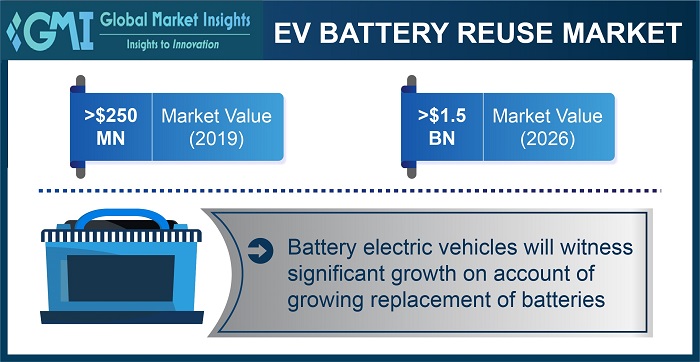EV battery reuse: The newest value addition to the energy storage sector
|
The dominance
of ICE vehicles is gradually fading as electric vehicles are
starting to take off in the global market, increasing from
3 million in 2020 to 6.6 million in 2021 to a probable
43 million by 2030. This growth of EVs and automakers’
electric commitments given the rising GHG levels have set an
exciting yet an unexplored path ahead for the automotive domain. As
beneficial as they are, the one ambiguity that concerns the fate of
EV batteries is that they are no longer in use in automobiles once
they reach the end of their service life.
Given the
surge in the use of EV batteries, it is crucial to have strategies
planned around battery management. Research activities and pilot
projects are underway to explore promising pathways, one of which is
EV battery reuse.
Currently
available EV batteries are generally perceived to be able to last
for at least 10 years. Over time, as they charge and discharge, they
start to degrade. But when they eventually become quite unsuitable
for fueling a car, they can be used elsewhere. A study by National
Renewable Energy Laboratory anticipates that these batteries are
likely to retain about
70% of their initial capacity even in their second use,
when treated properly.
Some of the
leading carmakers, including Tesla, Nissan, and Hyundai, have
forayed into the EV battery reuse market, and offered to rebuild or
refurbish battery packs in EVs. In a recent instance,
Hyundai, in 2021, announced partnering with two local
allies, OCI Solar Power and CPS Energy, in Texas to reuse EV
batteries as energy storage systems (ESS).
In yet
another EV battery reuse initiative, researchers at
Cornell University, partially backed by the U.S. National
Science Foundation, outlined ways to sustainably reuse Li-ion EV
batteries to cut down their carbon footprint. The aim behind this
was to investigate how reusing can influence the energy output and
environmental impact of these batteries. Through the analysis,
researchers were able to conclude that carbon footprint of Li-ion
batteries can be reduced to 17% if reused before recycling, later
being used to store solar and wind energy.
Various
central governments are working towards introducing incentives and
initiatives to support EV battery recycling and reuse across
different economies. Say for instance, one of the leading battery
makers in
Norway, announced receiving nearly $5 million from a
state enterprise owned by Ministry of Climate and Environment.
This makes
Norway one of the major hotspots, across the Europe, for EV battery
reuse market. A summary about the latest EV battery reuse trends
across the region is enumerated below.
Electric
mobility: Norway races ahead in EV sales
Norway, one
of the leading countries in EV market industry, recorded
74.8% of the EV sales in 2020. This has produced a
significant impetus for the EV battery market. The growth can be
ascribed to the favorable government policies, large EV battery
supply, and inexpensive and clean renewable energy. Moreover,
Norway’s rich natural resource base and exceptionally skilled
process industry is earmarked to enable the country to become a
world leader in battery reuse and recycling.
Norway’s
roadmap 2030: opportunity for battery re-use
The country
with 5 million people has an ambitious target of only selling
zero-emission passenger cars, city buses, and LCVs from 2025. The
government plans to work in tandem with EU requirements
for the reduction of carbon emissions from latest vehicles which
leads to increased availability of EV batteries across all segments.
In this regard, the EV batteries are likely to be available for
reuse in the country from 2025 with a significant surge in volume
towards 2030.
In 2020,
Hydro and Northvolt merger, HydroVolt, announced
establishing a recycling plant in Norway for Li-ion batteries from
EVs. Reports suggest that the plant will use aluminum from the
batteries to re-use them in operations in Hydro, while the remaining
materials would be processed by Northvolt in Sweden.
All in all,
increasing EV trend across the country and mounting cognizance
towards reusing the EV batteries will open positive growth
opportunities for the overall regional market in the years to
follow.
Supporting
green future with ESS: prominent EV battery reuse application
Energy
storage systems or ESS deployment is growing considerably, with
developers installing more projects at a rapid pace. These systems
can integrate renewables by transforming energy to high demand
periods or provide grid services like spinning reserve or frequency
control. In addition to being a key component in expansion of
renewables and making sure of a reliable, sustainable, and economic
power supply, ESS are also an important factor in sector coupling.
Many clean
energy technology companies are re-using EV batteries for energy
storage systems. In a recent example,
Exro Technologies announced repurposing evTS electric
vehicle batteries into second life ESS. The project aims to optimize
the FireFly ESV batteries, evTS’ flagship product, into a second
life, supporting 5 to 10 years of addition use, with its ESS.
Takeaway:
The end of an
electric vehicle’s life does not indicate the end of its battery.
Reuse is considered to be an economical resort to process the rising
number of lithium-ion EV batteries. A paradigm shift of EVs into
mainstream use has already disrupted the automotive value chain in
significant ways and is now on the verge of revolutionizing the
energy-storage value chain with the trend of EV battery reuse pacing
up. |

